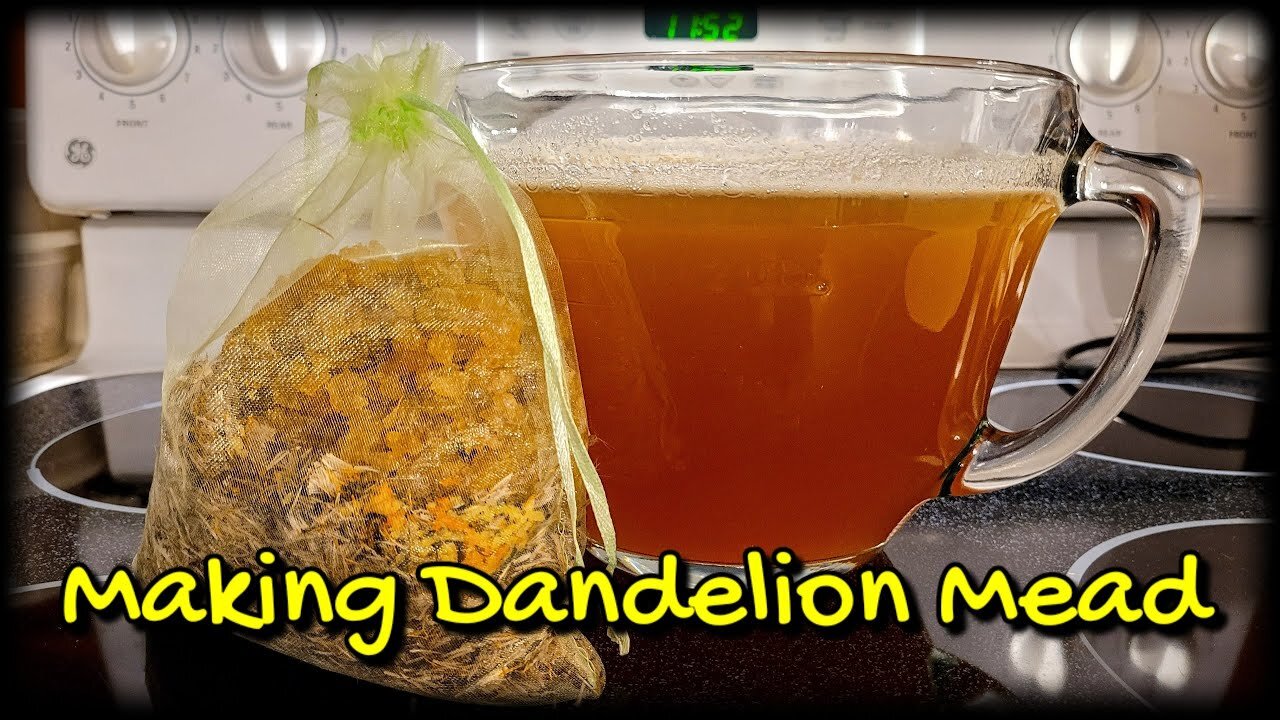Premium Only Content

Making Dandelion Mead From Start to Finish
A few years ago, my dad was telling me how his mom used to make jelly out of dandelions. I honestly thought that sounded pretty disgusting, but then I got to thinking...what all can these be used for? Jelly, wine, medicinal tinctures, mead?
At first I couldn't decide as to what to do with these dandelion petals. I have more than enough jellies that I have made in the past, so I opted for making mead.
Making mead is something I have never tried, and I'm always up for a challenge. I've made beer and wine in the past and those have turned out nicely, so this surely can't be that much harder, right?
The process behind making mead is longer than both wine and beer. This video is going to take you through a step-by-step process on getting started making mead. I don't think I left out any steps, but I'm putting the recipe I'm using below and links to the items used in the video in case anyone else wants to give it a try.
So, grab a cold one, sit back, and I'll tell you what you need to do.
Dandelion Mead Recipe
Ingredients
● 1 quart loosely packed dandelion petals
● ½ pound chopped white raisins
● 2 pounds (32 ounce) honey
● Juice and zest of 1 lemon
● Juice and zest of 1 orange
● ½ tsp powdered pectin enzyme
● ½ tsp acid blend
● ⅛ tsp grape tannin
● 1 crushed campden tablet
● water to ½ gallon
● ½ tsp yeast nutrient
● White wine yeast (Lalvin 71B)
Instructions
1. Bring 1 quart of water to a boil and add honey.
2. Boil for 20 minutes, skimming off any foam that appears.
3. Remove from heat, cover, and let cool.
4. While the honey water cools, chop the raisins and prepare the zest of the lemon and orange.
5. Combine dandelion petals, lemon and orange zest, and chopped raisins into a fine mesh straining bag.
6. Juice the lemon and orange into a small bowl.
7. Once honey water has cooled to room temperature, add enough water to bring the volume to ½ gallon.
8. Combine all ingredients except yeast into a primary fermenter and stir the contents.
9. Take a sample from the combined must and check specific gravity.
10. Pour sample back into the fermenter, cover with a towel, and let rest for 12 hours.
11. Add wine yeast and cover the primary fermenter with a towel.
12. Stir daily for 7-10 days until vigorous fermentation subsides.
13. Remove the mesh bag and allow it to drip into the fermenter, but do not squeeze.
14. Once it has finished draining, pour contents into the secondary fermenter, check specific gravity, and install a cover with an airlock in place.
15. Allow the must to ferment for 30 days, rack the mead, and check the specific gravity reading.
16. Crush the campden tablet and dissolve into the primary fermenter to aid with clearing.
17. Rack the mead every 30 days until sediment is mostly gone.
18. Once the sediment has been removed, allow the mead to rest for 6 months before bottling.
Products:
Dandelions - in your yard
Lemon, Orange, Water - locally purchased
Zester - https://www.amazon.com/Stainless-Chocolate-Vegetables-Protective-Cleaning/dp/B0B8SBRLG3/?th=1
Primary and Secondary Fermenters - https://www.amazon.com/gp/product/B01AK8GPIW/
Honey - https://www.amazon.com/gp/product/B00CMQD3VS/
Golden Raisins - https://www.amazon.com/gp/product/B000JMDHG8/
Campden Tablets - https://www.amazon.com/gp/product/B0064H0KC6/
Mead/Wine Yeast - https://www.amazon.com/gp/product/B0BG3G579V/
Wine Tannin, Pectin Enzyme, and Acid Blend - https://www.amazon.com/gp/product/B00UKJG5LY/
Yeast Nutrient - https://www.amazon.com/gp/product/B07F97BSGM/
-
 19:52
19:52
Adam Does Movies
6 hours ago $2.36 earnedEmilia Pérez Movie Review - It's Uniquely Awful
27.3K3 -
 20:07
20:07
BlackDiamondGunsandGear
12 hours agoSPRINGFIELD ECHELON COMPACT / NOT GOOD
34.2K3 -
 1:05:06
1:05:06
Man in America
12 hours agoThe Terrifying Truth Behind Chemical Fog, Wildfire Smoke & Chemtrails w/ Dr. Robert Young
27.7K28 -
 2:54:47
2:54:47
Tundra Tactical
5 hours ago $1.03 earnedSHOT Show 2025 Wrap Up!! On The Worlds Okayest Gun Live Stream
27.9K -
 LIVE
LIVE
Right Side Broadcasting Network
1 day agoLIVE REPLAY: President Donald J. Trump Holds His First Rally After Inauguration in Las Vegas - 1/25/25
3,395 watching -
 2:55:24
2:55:24
Jewels Jones Live ®
1 day agoWEEK ONE IN REVIEW | A Political Rendezvous - Ep. 107
115K40 -
 1:33:29
1:33:29
Michael Franzese
1 day agoTrump Wastes No Time: Breaking Down Trump’s First Week Executive Orders | LIVE
126K92 -
 1:26:44
1:26:44
Tactical Advisor
15 hours agoTrump Starting Strong/Shot Show Recap | Vault Room Live Stream 015
90.8K9 -
 10:18
10:18
MrBigKid
10 hours ago $2.06 earnedInsanely Compact Hunting Tripod you HAVEN'T heard of... Revolve
47.4K5 -
 20:29
20:29
marcushouse
17 hours ago $8.06 earnedUnleashing the Power of SpaceX's Starship: Why is it a Big Deal!?
82.6K11